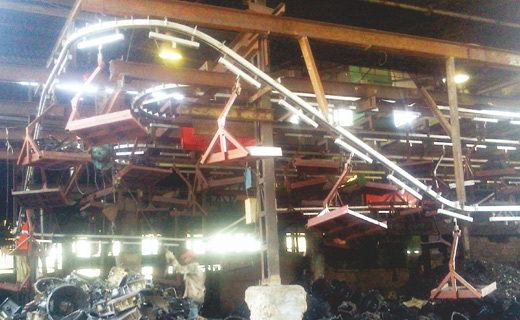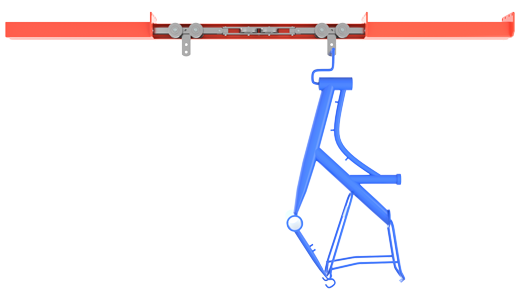Foundaries
Enabling easy transfer of Castings and better space utilization for Foundaries
Red-hot Castings manufactured out of foundries are often dumped on the ground for cooling off until the further process of fine chipping. Handling of red hot castings itself is a first challenge, storage of these castings for cooling consumes a lot of space on the floor.
With Statfield’s Overhead Conveyors, these castings can be easily transferred from one location to another without any hassle. Furthermore by using vertical heights castings can be stored above operations area to cool off.


Challenges
- Ergonomic handling of Cylinders
- Intense dependency on human resources for material transfers
Advantages of overhead conveyor
- Ergonomic operations, zero human injuries
- Better throughout with ease of handling
- Effective use of vertical height for storage purposes
Frequently Asked Questions
Can your conveyor handle the extreme heat and abrasive conditions of a foundry?
Absolutely. Our foundry-duty conveyors are built with heat-resistant alloys for chains and trolleys, and often feature enclosed track designs to protect critical components from abrasive sand, dust, and debris. They are specifically engineered to withstand the harsh environment near melting, pouring, and cooling areas.
What is the maximum load capacity for handling heavy castings, molds, or flasks?
We specialize in heavy-duty systems capable of handling extremely high loads, from individual castings to full mold lines. Capacities can be engineered to support many tons per carrier, using reinforced track, heavy-duty drive units, and robust trolley designs to safely move your most substantial products.
How does the system transport hot castings through the cooling process?
Our conveyors provide a continuous, automated flow for controlled cooling. Hot castings can be transferred from the shakeout onto the conveyor, which moves them through a designated cooling tunnel or zone. This ensures a consistent cooling rate, improves workplace safety by removing hot parts from the floor, and optimizes the production cycle.
We deal with a lot of sand and spillage. How is the system protected from contamination?
Our enclosed track and double-flanged wheel designs are ideal for this. They prevent sand and fine particulates from entering the chain and bearing areas, which is the primary cause of premature wear and failure. This design significantly extends the system’s lifespan and reduces maintenance.
Is the system suitable for moving sand molds through a pouring line?
What kind of maintenance should we expect in such a dirty environment?
While built for durability, foundry conveyors require a disciplined maintenance routine focused on:
Regular Inspection: Frequent checks for wear on chains, trolley wheels, and tracks.
Specialized Lubrication: Using high-temperature, graphite-based or synthetic lubricants that won’t burn off and can resist dust.
Component Protection: Utilizing protective guards and scrapers to minimize abrasive material ingress.
How do you manage thermal expansion on long conveyor runs that go through hot and cold zones?
We engineer the system to account for thermal expansion and contraction. This includes using expansion loops, slip splices in the track and floating drive mounts. These features allow the track to expand and contract without causing stress, misalignment, or damage to the structure.
What safety features are critical in a foundry environment?
Key safety features include:
Overload Protection: To prevent damage if a carrier snags.
Emergency Stop Cords: Running the entire length of the conveyor.
Heat Shields and Guards: To protect both the conveyor and personnel from radiant heat and molten metal splash.
Fail-Safe Brakes: On inclines, especially those leading to shakeouts or drop zones.
